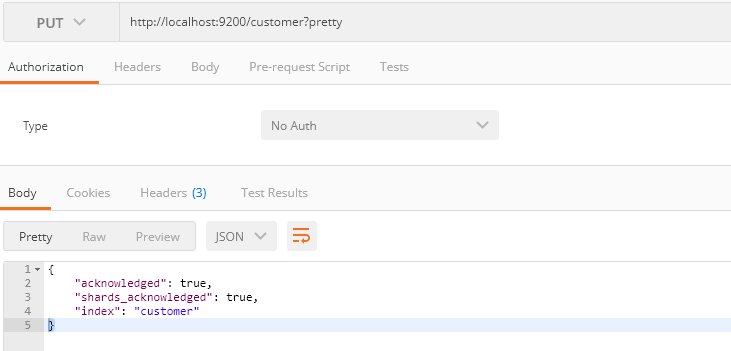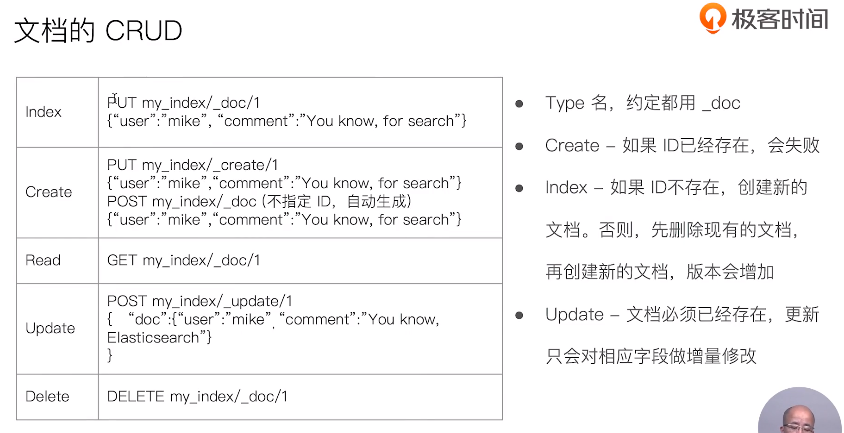熟悉了elasticsearch 的基本概念后,可以动手实践了,实践才能出真知。
显示索引列表
curl http://localhost:9200/_cat/indices?v
health status index uuid pri rep docs.count docs.deleted store.size pri.store.size
yellow open accounts MtqOgd0aTb6emn2rj-VfNQ 1 1 2 0 5kb 5kb
用来表示当前系统中有哪些索引,一个索引用一行来记录来表示,每条数据记录索引的基本情况
- index :索引名
- docs.count:文档数量
创建索引
使用 PUT 请求,创建一个名叫 custmer 的索引
curl -X PUT "localhost:9200/customer?pretty"
或者使用PostMan操作

返回结果
{
"acknowledged" : true,
"shards_acknowledged" : true,
"index" : "customer"
}
创建索引时,可以指定一些配置参数,例如分析器,在后面章节有介绍。
删除索引
用 DELETE 请求删除 customer 索引。
curl -X DELETE "localhost:9200/customer?pretty"
acknowledged 表示删除成功
{
"acknowledged" : true
}
创建文档

创建文档就是将文档加入索引库中方便后面检索。用POST请求,不需要指定文档ID,系统会自动分配唯一ID。(如果要自己指定id,就用PUT方式)
POST /customer/_doc?pretty
{
"name": "张翠山",
"address": "湖北十堰"
}
返回id为0xMBGGoB15mDBRoAwkbg的文档。
{
"_index": "customer",
"_type": "_doc",
"_id": "0xMBGGoB15mDBRoAwkbg",
"_version": 1,
"result": "created",
"_shards": {
"total": 2,
"successful": 1,
"failed": 0
},
"_seq_no": 3,
"_primary_term": 1
}
或者用create的方式创建, 创建id为的1的文档。如果该文档已经存在与索引中,则会报错。
PUT users/_doc/1?op_type=create
{
xxxxxx
}
或者
PUT users/_create/1
{
xxxxxx
}
替换文档
在 customer 索引下创建或替换 id 为 1 的文档,文档是json格式,该文档有两个字段。注意这里用的是 PUT 方法,同时在url中指定了文档 id,当该id对应的文档不存在时创建新的文档。如果原文章存在,所有字段将全部被替换
PUT /customer/_doc/1?pretty
Content-Type: application/json
{
"name": "张三丰",
"address": "广东深圳"
}
返回结果:
{
"_index" : "customer",
"_type" : "_doc",
"_id" : "1",
"_version" : 1,
"result" : "created",
"_shards" : {
"total" : 2,
"successful" : 1,
"failed" : 0
},
"_seq_no" : 0,
"_primary_term" : 1
}
查找文档
在 custmer 索引下找id 等于 1 的文档
GET /customer/_doc/1?pretty
返回:
{
"_index": "customer",
"_type": "_doc",
"_id": "1",
"_version": 3,
"_seq_no": 2,
"_primary_term": 1,
"found": true,
"_source": {
"name": "张三丰",
"address": "广东深圳"
}
}
如果没找到返回的结果是:
{
"_index" : "customer",
"_type" : "_doc",
"_id" : "3",
"found" : false
}
不过我们在实际应用场景中,很少通过文档id去查找,而是通过模糊匹配全文检索,而且支持多个字段的搜索,例如输入关键字"python",可以在文档的 title 字段搜索,也可以在文档的 content 字段搜索。关于搜索API,后面再详细介绍
更新文档
当原数据(比如MySQL)有更新时,我们要及时将更新同步索引中的文档才能正确检索到结果。前面介绍了用PUT请求对文档进行替换,但如果并不是每个字段都需要更新的时候,我们也可以单独针对某一个字段进行更新。
注意这里是 POST 请求, URL 的前缀是 _update, 并指定 ID 为 1,比如我们只修改名字,其他字段不变
POST /customer/_update/1?pretty
{
"doc": { "name": "张真人" }
}
返回
{
"_index": "customer",
"_type": "_doc",
"_id": "1",
"_version": 6,
"result": "updated",
"_shards": {
"total": 2,
"successful": 1,
"failed": 0
},
"_seq_no": 6,
"_primary_term": 1
}
更新的原理其实还是建立在替换的基础之上,他会把旧的文档删除,然后创建一个新的。
删除文档
用 DELETE 请求删除指定文档
DELETE /customer/_doc/1BMNGGoB15mDBRoAVUZF?pretty
返回:
{
"_index": "customer",
"_type": "_doc",
"_id": "1BMNGGoB15mDBRoAVUZF",
"_version": 2,
"result": "deleted",
"_shards": {
"total": 2,
"successful": 1,
"failed": 0
},
"_seq_no": 8,
"_primary_term": 1
}
批量操作
在一个请求中可以批量操作,一次添加多个文档,或者更新文档的同时删除另外一个文档,非常灵活。例如:添加两个文档(注意数据最后一行要有回车换行)批量操作的格式是:
action_and_meta_data\n
optional_source\n
action_and_meta_data\n
optional_source\n
...
批量添加两个文档
POST /customer/_bulk?pretty
{"index":{"_id":"3"}}
{"name": "张无忌", "address":"万安寺" }
{"index":{"_id":"4"}}
{"name": "赵敏", "address":"蒙古草原" }
返回结果:
{
"took": 15,
"errors": false,
"items": [
{
"index": {
"_index": "customer",
"_type": "_doc",
"_id": "3",
"_version": 1,
"result": "created",
"_shards": {
"total": 2,
"successful": 1,
"failed": 0
},
"_seq_no": 9,
"_primary_term": 1,
"status": 201
}
},
{
"index": {
"_index": "customer",
"_type": "_doc",
"_id": "4",
"_version": 1,
"result": "created",
"_shards": {
"total": 2,
"successful": 1,
"failed": 0
},
"_seq_no": 10,
"_primary_term": 1,
"status": 201
}
}
]
}
更新id为1的name,同时删除id为2的文档
POST /customer/_bulk?pretty
{"update":{"_id":"1"}}
{"doc": { "name": "John Doe becomes Jane Doe" } }
{"delete":{"_id":"2"}}
5种操作用一张图总结如下:

index
create
update
delete
doc
批量读取
GET /_mget
{
"docs" : [
{
"_index": "test",
"_id": 1
},
{
"_index": "test",
"_id": 2
}
]
}
文档查询
Elasticsearch 的查询语法非常强大单独放在下一节
参考:https://www.elastic.co/guide/en/elasticsearch/reference/current/getting-started-search-API.html
添加新字段
PUT http://localhost:9200/account/_mapping
{
"properties": {
"last_post_at": {
"type": "date"
}
}
}
{
"acknowledged": true
}
关注公众号「Python之禅」,回复「1024」免费获取Python资源
